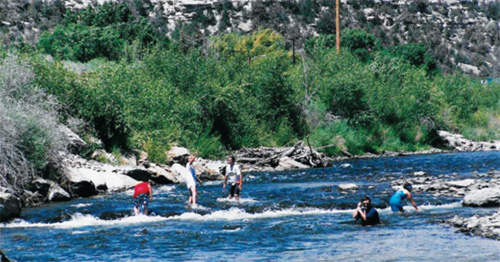
This Dolores River swimming hole shows the recreational use of water, when there is enough.
I think that I shall never see a poem lovely as a tree. This verse by Joyce Kilmer just brought some visual image into your mind, I bet! Now consider cooling water, you quench your thirst. Of all the drinks, I choose you first. Another image popped up, right? Now combine the two images and you have a babbling stream in a forest. These are two resources that are important to all of us. The different trees provide food and shelter for man and beast and the water is necessary to sustain the lives of the trees and man and beast. That all sounds like a symphony of life where all forms of life are in a symbiotic and peaceful existence. NOPE! Who would think those two would cause so many fights?
Nature is in a continuous struggle of life and death between plants and animals. They really don’t care about the other plants’ and animals’ needs, not even of their own kind. Nature is very selfish and cruel. Animals fight for their territory and food, birds do the same. Trees and flowering plants crowd out others. They all fight for water!
Where does man fit into this natural scheme of things? When man was created, he was made “above” the animals and birds and instructed to “tend” to the trees (that is an action word), not sit on his duff and wait to be fed while singing Kumbaya with the animals. Man was given the ability to reason and to manage his life while considering and using the animal and plant life. All went well for about a week or two and if you study any history, you know that man became more like the animals in seeking to dominate others and not interested in sharing in shelter, food or water, the basic necessities of life, or even the pleasures of life.
That brings us to today and the controversies over life and our environment. We are now at a photo point in time and seeing that we have flourished here in the Montezuma Valley, due to our ancestors’ hard work, sweat, and tears; developing the resources of lands, forests, minerals and waters to build a beautiful agricultural valley to feed themselves and others (that’s us) and enabled the wildlife to flourish beyond what existed before. Today we are seeing new “land and water wars” where recreationists want the water to boat on and the land to hike, bike or ride on. The recreationists don’t want to share the same land with other recreationists, and the environmentalists don’t want to share with anyone. The Front Range of Colorado wants the West Slope water. States of Arizona, California and Mexico want our water. Our agriculture needs water (lots of hemp and marijuana growing now), and some people still think they have to flush toilets and take showers. Who has first priority? Is there enough to go around?
I bring this all up after the past two interesting weather years. In water year 2018, I recorded 6.4 inches of total precipitation, a nasty drought! We all worried, but then this past water year, which started last Oct. 1, we had record snows and moisture of 16.5 inches by the end of May, only 8 months. Wow! We thought we were saved, we even had to release water out of McPhee for the boaters. Not so fast! The faucet got screwed down and we only had 0.76 inch in the next 4 months to end the water year on Sept. 30. Now we are starting off a new year with unusually dry soil in the forest and range lands.
This begins a new year of wonderment, will it be a dry or wet or snowy winter? We do not know and blaming California’s cars and Denver’s hot air does not solve anything. Our water supply will depend upon two principal things, the weather pattern and the vegetation on the ground. Trees are a big player in this, as too many trees prevent some snow and even rain from reaching the ground, and what does get down is immediately sucked up by the trees. Too few trees exposes the snow to high solar radiation and winds that evaporate the snow without even melting it into useable water. What you see is most likely not what you will get!
There have been many watershed research studies conducted here in the Southwest since the 1950s. We know that the forest watersheds need serious management of the trees and protection of the watersheds. We know how to do it, we just need to remove the blockades that have been put in place to prevent management over the past several decades. Is a New Mexico jumping mouse or a Mexican spotted owl or an environmental lawyer going to stop management works to enable Colorado to meet its commitment of water in the Colorado River Compact while still providing enough for agriculture and you to swim in and flush the toilet? I hope not! Work must be started now to develop more forest products industries to enable management and protection of the forests of the state to regain their health and produce the maximum quantity and quality of water possible. This all involves working the land and resources, just as our ancestors did before us in their quest to turn this dry dusty basin into the green valley we all love. All day I faced the barren waste without the taste of water, cool clear water…. And the song goes on, will we?
Dexter Gill is a retired forest manager who worked for private industry, three Western state forestry agencies, and the Navajo Nation forestry department. He writes from Lewis, Colo.








